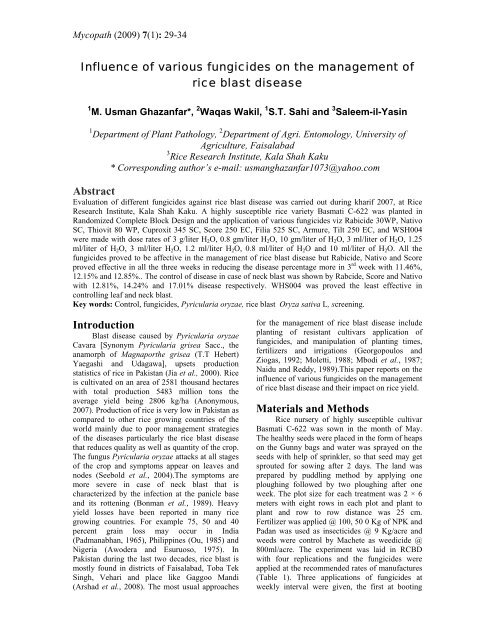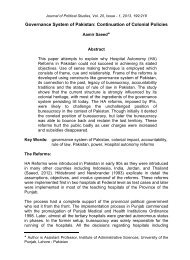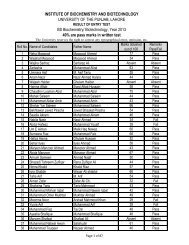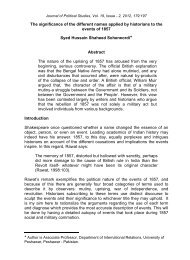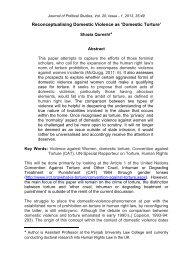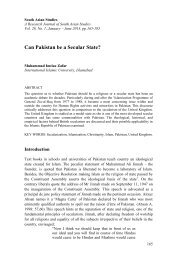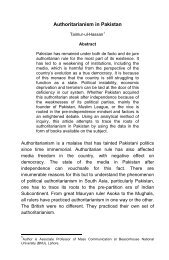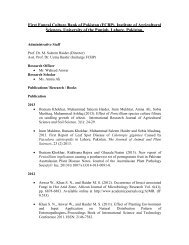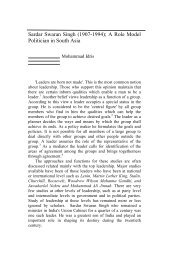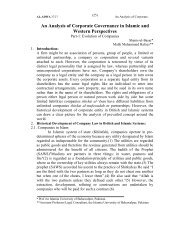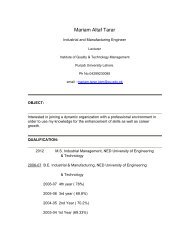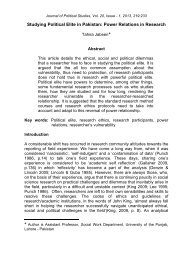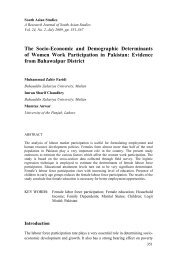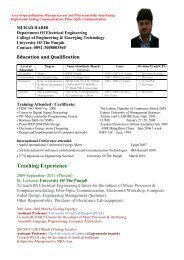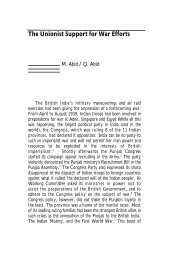Influence of various fungicides on the management of rice blast ...
Influence of various fungicides on the management of rice blast ...
Influence of various fungicides on the management of rice blast ...
Create successful ePaper yourself
Turn your PDF publications into a flip-book with our unique Google optimized e-Paper software.
Mycopath (2009) 7(1): 29-34<br />
<str<strong>on</strong>g>Influence</str<strong>on</strong>g> <str<strong>on</strong>g>of</str<strong>on</strong>g> <str<strong>on</strong>g>various</str<strong>on</strong>g> <str<strong>on</strong>g>fungicides</str<strong>on</strong>g> <strong>on</strong> <strong>the</strong> <strong>management</strong> <str<strong>on</strong>g>of</str<strong>on</strong>g><br />
<strong>rice</strong> <strong>blast</strong> disease<br />
1 M. Usman Ghazanfar*, 2 Waqas Wakil, 1 S.T. Sahi and 3 Saleem-il-Yasin<br />
1 Department <str<strong>on</strong>g>of</str<strong>on</strong>g> Plant Pathology, 2 Department <str<strong>on</strong>g>of</str<strong>on</strong>g> Agri. Entomology, University <str<strong>on</strong>g>of</str<strong>on</strong>g><br />
Agriculture, Faisalabad<br />
3 Rice Research Institute, Kala Shah Kaku<br />
* Corresp<strong>on</strong>ding author’s e-mail: usmanghazanfar1073@yahoo.com<br />
Abstract<br />
Evaluati<strong>on</strong> <str<strong>on</strong>g>of</str<strong>on</strong>g> different <str<strong>on</strong>g>fungicides</str<strong>on</strong>g> against <strong>rice</strong> <strong>blast</strong> disease was carried out during kharif 2007, at Rice<br />
Research Institute, Kala Shah Kaku. A highly susceptible <strong>rice</strong> variety Basmati C-622 was planted in<br />
Randomized Complete Block Design and <strong>the</strong> applicati<strong>on</strong> <str<strong>on</strong>g>of</str<strong>on</strong>g> <str<strong>on</strong>g>various</str<strong>on</strong>g> <str<strong>on</strong>g>fungicides</str<strong>on</strong>g> viz Rabicide 30WP, Nativo<br />
SC, Thiovit 80 WP, Cuproxit 345 SC, Score 250 EC, Filia 525 SC, Armure, Tilt 250 EC, and WSH004<br />
were made with dose rates <str<strong>on</strong>g>of</str<strong>on</strong>g> 3 g/liter H2O, 0.8 gm/liter H2O, 10 gm/liter <str<strong>on</strong>g>of</str<strong>on</strong>g> H2O, 3 ml/liter <str<strong>on</strong>g>of</str<strong>on</strong>g> H2O, 1.25<br />
ml/liter <str<strong>on</strong>g>of</str<strong>on</strong>g> H2O, 3 ml/liter H2O, 1.2 ml/liter H2O, 0.8 ml/liter <str<strong>on</strong>g>of</str<strong>on</strong>g> H2O and 10 ml/liter <str<strong>on</strong>g>of</str<strong>on</strong>g> H2O. All <strong>the</strong><br />
<str<strong>on</strong>g>fungicides</str<strong>on</strong>g> proved to be affective in <strong>the</strong> <strong>management</strong> <str<strong>on</strong>g>of</str<strong>on</strong>g> <strong>rice</strong> <strong>blast</strong> disease but Rabicide, Nativo and Score<br />
proved effective in all <strong>the</strong> three weeks in reducing <strong>the</strong> disease percentage more in 3 rd week with 11.46%,<br />
12.15% and 12.85%.. The c<strong>on</strong>trol <str<strong>on</strong>g>of</str<strong>on</strong>g> disease in case <str<strong>on</strong>g>of</str<strong>on</strong>g> neck <strong>blast</strong> was shown by Rabcide, Score and Nativo<br />
with 12.81%, 14.24% and 17.01% disease respectively. WHS004 was proved <strong>the</strong> least effective in<br />
c<strong>on</strong>trolling leaf and neck <strong>blast</strong>.<br />
Key words: C<strong>on</strong>trol, <str<strong>on</strong>g>fungicides</str<strong>on</strong>g>, Pyricularia oryzae, <strong>rice</strong> <strong>blast</strong> Oryza sativa L, screening.<br />
Introducti<strong>on</strong><br />
Blast disease caused by Pyricularia oryzae<br />
Cavara [Syn<strong>on</strong>ym Pyricularia grisea Sacc., <strong>the</strong><br />
anamorph <str<strong>on</strong>g>of</str<strong>on</strong>g> Magnapor<strong>the</strong> grisea (T.T Hebert)<br />
Yaegashi and Udagawa], upsets producti<strong>on</strong><br />
statistics <str<strong>on</strong>g>of</str<strong>on</strong>g> <strong>rice</strong> in Pakistan (Jia et al., 2000). Rice<br />
is cultivated <strong>on</strong> an area <str<strong>on</strong>g>of</str<strong>on</strong>g> 2581 thousand hectares<br />
with total producti<strong>on</strong> 5483 milli<strong>on</strong> t<strong>on</strong>s <strong>the</strong><br />
average yield being 2806 kg/ha (An<strong>on</strong>ymous,<br />
2007). Producti<strong>on</strong> <str<strong>on</strong>g>of</str<strong>on</strong>g> <strong>rice</strong> is very low in Pakistan as<br />
compared to o<strong>the</strong>r <strong>rice</strong> growing countries <str<strong>on</strong>g>of</str<strong>on</strong>g> <strong>the</strong><br />
world mainly due to poor <strong>management</strong> strategies<br />
<str<strong>on</strong>g>of</str<strong>on</strong>g> <strong>the</strong> diseases particularly <strong>the</strong> <strong>rice</strong> <strong>blast</strong> disease<br />
that reduces quality as well as quantity <str<strong>on</strong>g>of</str<strong>on</strong>g> <strong>the</strong> crop.<br />
The fungus Pyricularia oryzae attacks at all stages<br />
<str<strong>on</strong>g>of</str<strong>on</strong>g> <strong>the</strong> crop and symptoms appear <strong>on</strong> leaves and<br />
nodes (Seebold et al., 2004).The symptoms are<br />
more severe in case <str<strong>on</strong>g>of</str<strong>on</strong>g> neck <strong>blast</strong> that is<br />
characterized by <strong>the</strong> infecti<strong>on</strong> at <strong>the</strong> panicle base<br />
and its rottening (B<strong>on</strong>man et al., 1989). Heavy<br />
yield losses have been reported in many <strong>rice</strong><br />
growing countries. For example 75, 50 and 40<br />
percent grain loss may occur in India<br />
(Padmanabhan, 1965), Philippines (Ou, 1985) and<br />
Nigeria (Awodera and Esuruoso, 1975). In<br />
Pakistan during <strong>the</strong> last two decades, <strong>rice</strong> <strong>blast</strong> is<br />
mostly found in districts <str<strong>on</strong>g>of</str<strong>on</strong>g> Faisalabad, Toba Tek<br />
Singh, Vehari and place like Gaggoo Mandi<br />
(Arshad et al., 2008). The most usual approaches<br />
for <strong>the</strong> <strong>management</strong> <str<strong>on</strong>g>of</str<strong>on</strong>g> <strong>rice</strong> <strong>blast</strong> disease include<br />
planting <str<strong>on</strong>g>of</str<strong>on</strong>g> resistant cultivars applicati<strong>on</strong> <str<strong>on</strong>g>of</str<strong>on</strong>g><br />
<str<strong>on</strong>g>fungicides</str<strong>on</strong>g>, and manipulati<strong>on</strong> <str<strong>on</strong>g>of</str<strong>on</strong>g> planting times,<br />
fertilizers and irrigati<strong>on</strong>s (Georgopoulos and<br />
Ziogas, 1992; Moletti, 1988; Mbodi et al., 1987;<br />
Naidu and Reddy, 1989).This paper reports <strong>on</strong> <strong>the</strong><br />
influence <str<strong>on</strong>g>of</str<strong>on</strong>g> <str<strong>on</strong>g>various</str<strong>on</strong>g> <str<strong>on</strong>g>fungicides</str<strong>on</strong>g> <strong>on</strong> <strong>the</strong> <strong>management</strong><br />
<str<strong>on</strong>g>of</str<strong>on</strong>g> <strong>rice</strong> <strong>blast</strong> disease and <strong>the</strong>ir impact <strong>on</strong> <strong>rice</strong> yield.<br />
Materials and Methods<br />
Rice nursery <str<strong>on</strong>g>of</str<strong>on</strong>g> highly susceptible cultivar<br />
Basmati C-622 was sown in <strong>the</strong> m<strong>on</strong>th <str<strong>on</strong>g>of</str<strong>on</strong>g> May.<br />
The healthy seeds were placed in <strong>the</strong> form <str<strong>on</strong>g>of</str<strong>on</strong>g> heaps<br />
<strong>on</strong> <strong>the</strong> Gunny bags and water was sprayed <strong>on</strong> <strong>the</strong><br />
seeds with help <str<strong>on</strong>g>of</str<strong>on</strong>g> sprinkler, so that seed may get<br />
sprouted for sowing after 2 days. The land was<br />
prepared by puddling method by applying <strong>on</strong>e<br />
ploughing followed by two ploughing after <strong>on</strong>e<br />
week. The plot size for each treatment was 2 × 6<br />
meters with eight rows in each plot and plant to<br />
plant and row to row distance was 25 cm.<br />
Fertilizer was applied @ 100, 50 0 Kg <str<strong>on</strong>g>of</str<strong>on</strong>g> NPK and<br />
Padan was used as insecticides @ 9 Kg/acre and<br />
weeds were c<strong>on</strong>trol by Machete as weedicide @<br />
800ml/acre. The experiment was laid in RCBD<br />
with four replicati<strong>on</strong>s and <strong>the</strong> <str<strong>on</strong>g>fungicides</str<strong>on</strong>g> were<br />
applied at <strong>the</strong> recommended rates <str<strong>on</strong>g>of</str<strong>on</strong>g> manufactures<br />
(Table 1). Three applicati<strong>on</strong>s <str<strong>on</strong>g>of</str<strong>on</strong>g> <str<strong>on</strong>g>fungicides</str<strong>on</strong>g> at<br />
weekly interval were given, <strong>the</strong> first at booting
30 Ghazanfar et al.<br />
stage. The data regarding <strong>the</strong> occurrence <str<strong>on</strong>g>of</str<strong>on</strong>g> <strong>the</strong><br />
<strong>blast</strong> disease was collected <strong>on</strong>e week after <strong>the</strong> last<br />
applicati<strong>on</strong> <str<strong>on</strong>g>of</str<strong>on</strong>g> <str<strong>on</strong>g>fungicides</str<strong>on</strong>g> by using <strong>the</strong> disease<br />
rating scale <str<strong>on</strong>g>of</str<strong>on</strong>g> 0-9 developed by Internati<strong>on</strong>al Rice<br />
Research Institute (IRRI. 1996) and <strong>the</strong>n<br />
c<strong>on</strong>verting into percent disease by using <strong>the</strong><br />
formulas.<br />
Disease % = Average <str<strong>on</strong>g>of</str<strong>on</strong>g> <strong>the</strong> disease score X 100<br />
9<br />
or<br />
Disease % = Sum <str<strong>on</strong>g>of</str<strong>on</strong>g> <strong>the</strong> scores X 100<br />
Number <str<strong>on</strong>g>of</str<strong>on</strong>g> observati<strong>on</strong> X higest number in rating sacle<br />
The data <strong>on</strong> <strong>the</strong> yield were recorded by marking 3<br />
× 2 m secti<strong>on</strong> with-in each plot using a wire frame<br />
as described by (Seebold et al., 2004) and tillers<br />
with-in <strong>the</strong> frame were cut and harvested in order<br />
to determine <strong>the</strong> yield.<br />
Results and Discussi<strong>on</strong><br />
Evaluati<strong>on</strong> <str<strong>on</strong>g>of</str<strong>on</strong>g> different <str<strong>on</strong>g>fungicides</str<strong>on</strong>g> <strong>on</strong> leaf<br />
and neck <strong>blast</strong> under field c<strong>on</strong>diti<strong>on</strong>s and <strong>the</strong>ir<br />
ultimate effect <strong>on</strong> crop yield is given in <strong>the</strong> (Fig 1,<br />
2 and 3). The results showed that after <strong>the</strong><br />
applicati<strong>on</strong> <str<strong>on</strong>g>of</str<strong>on</strong>g> <str<strong>on</strong>g>various</str<strong>on</strong>g> <str<strong>on</strong>g>fungicides</str<strong>on</strong>g> against leaf <strong>blast</strong><br />
after <strong>the</strong> first week, <strong>the</strong> <str<strong>on</strong>g>fungicides</str<strong>on</strong>g> Armure<br />
(Propic<strong>on</strong>azol + Difenoc<strong>on</strong>azole), Rabicide<br />
(Tetrachlorophthalide), Score (Difenoc<strong>on</strong>azole),<br />
showed <strong>the</strong> best results with disease percentage <str<strong>on</strong>g>of</str<strong>on</strong>g><br />
28.11%, 30.61% and 30.92% respectively. The<br />
<str<strong>on</strong>g>fungicides</str<strong>on</strong>g> like Nativo (Tebuc<strong>on</strong>azole +<br />
Trifloxystobin) and Tilt (Propic<strong>on</strong>azole) showed<br />
intermediate results and <strong>the</strong> disease percentage<br />
recorded was 31.44% and 32.63%. WSH004 was<br />
<strong>the</strong> least effective <str<strong>on</strong>g>of</str<strong>on</strong>g> all <strong>the</strong> <str<strong>on</strong>g>fungicides</str<strong>on</strong>g> in<br />
c<strong>on</strong>trolling <strong>the</strong> <strong>blast</strong> disease and <strong>the</strong> disease<br />
percentage was recorded up to 38.11%. Similar<br />
results were shown after 2 nd week in Rabicide,<br />
Natvio and Score remained more effective against<br />
<strong>blast</strong>, disease percentage recorded was 24.08%,<br />
25.48% and 26.72%. Cuproxa, Tilt, Armure<br />
exhibited intermediate effectiveness and disease<br />
percentage recorded was 27.36%, 26.72% and<br />
27.36%. Haq et al., (2002) c<strong>on</strong>ducted an<br />
experiment to evaluate <str<strong>on</strong>g>various</str<strong>on</strong>g> <str<strong>on</strong>g>fungicides</str<strong>on</strong>g> like<br />
Captan, Acrobat, Bayeltan, Sunlet, Dithane M-45<br />
Trimiltox and Derosal in c<strong>on</strong>trolling <strong>the</strong> mycelial<br />
growth <str<strong>on</strong>g>of</str<strong>on</strong>g> Pyricularia oryzae under <strong>the</strong> laboratory<br />
c<strong>on</strong>diti<strong>on</strong>s and found that Captan and Acrobat<br />
were <strong>the</strong> most effective <str<strong>on</strong>g>fungicides</str<strong>on</strong>g>.<br />
The <str<strong>on</strong>g>fungicides</str<strong>on</strong>g> viz Rabicide, Nativo and<br />
Score were <strong>the</strong> most effective against leaf <strong>blast</strong><br />
disease with great reducti<strong>on</strong> in <strong>the</strong> disease<br />
percentage which was 11.46%, 12.15% and<br />
Mycopath (2009) 7(1): 29-34<br />
12.85% respectively after <strong>the</strong> third week, while<br />
Tilt and Armure, exhibited intermediate<br />
effectiveness with 15.97% and 17.36% disease<br />
percentage. In all <strong>the</strong> three weeks WSH004 proved<br />
least effective for <strong>the</strong> <strong>management</strong> <str<strong>on</strong>g>of</str<strong>on</strong>g> <strong>the</strong> disease.<br />
In case <str<strong>on</strong>g>of</str<strong>on</strong>g> neck <strong>blast</strong> (Fig 2) Armure, Tilt<br />
and Score was <strong>the</strong> most effective during first week<br />
<str<strong>on</strong>g>of</str<strong>on</strong>g> spray at heading stage with 31.32%, 32.56%<br />
and 33.33% disease occurrence, where as<br />
Rabicide, Cuproxat and Filia showed intermediate<br />
results, 34.07%, 36.94% and 37.19%. In sec<strong>on</strong>d<br />
week fungicide applicati<strong>on</strong> for <strong>the</strong> purpose to<br />
c<strong>on</strong>trol neck <strong>blast</strong> Rabicide, Score, Armure were<br />
more efficient <str<strong>on</strong>g>of</str<strong>on</strong>g> all <str<strong>on</strong>g>fungicides</str<strong>on</strong>g> used and disease<br />
recorded was 29.08%, 30.33%, and 30.40%.<br />
respectively On <strong>the</strong> o<strong>the</strong>r hand Tilt, Nativo,<br />
Thiovit were statistically at par with each o<strong>the</strong>r<br />
and showed 30.89%, 32 89%,and 34.39% disease.<br />
In third week <str<strong>on</strong>g>of</str<strong>on</strong>g> spray disease percentage recorded<br />
was 12.81%, 14.24%, 17.01% by <strong>the</strong> applicati<strong>on</strong><br />
<str<strong>on</strong>g>of</str<strong>on</strong>g> Rabicide, Score and Nativo, for <strong>the</strong> c<strong>on</strong>trol <str<strong>on</strong>g>of</str<strong>on</strong>g><br />
<strong>rice</strong> neck <strong>blast</strong> disease. The <str<strong>on</strong>g>fungicides</str<strong>on</strong>g> Pulsor, Tilt,<br />
Filia showed intermediately resp<strong>on</strong>se with<br />
21.18%, 21.18%, and 22.57%.disease WSH004<br />
was <strong>the</strong> less effective <str<strong>on</strong>g>of</str<strong>on</strong>g> all <strong>the</strong> <str<strong>on</strong>g>fungicides</str<strong>on</strong>g> in<br />
reducing <strong>the</strong> <strong>rice</strong> neck <strong>blast</strong> in all <strong>the</strong> three weeks<br />
with 40.89%, 42.0% and 52.08% disease.<br />
Similar results regarding <strong>the</strong> efficacy <str<strong>on</strong>g>of</str<strong>on</strong>g><br />
<str<strong>on</strong>g>various</str<strong>on</strong>g> <str<strong>on</strong>g>fungicides</str<strong>on</strong>g> has been reported by different<br />
researchers through out <strong>the</strong> world like Varier et al.,<br />
(1993) used eight fungicide for <strong>management</strong> <str<strong>on</strong>g>of</str<strong>on</strong>g><br />
<strong>rice</strong> <strong>blast</strong> and seed treatment with tricyclazole @<br />
4kg/kg seed proved effective after 40 days <str<strong>on</strong>g>of</str<strong>on</strong>g><br />
sowing. Dubey (1995) c<strong>on</strong>ducted field trails <str<strong>on</strong>g>of</str<strong>on</strong>g><br />
eight <str<strong>on</strong>g>fungicides</str<strong>on</strong>g> for c<strong>on</strong>trol <str<strong>on</strong>g>of</str<strong>on</strong>g> Pyricularia oryzae,<br />
Topsin M + Ind<str<strong>on</strong>g>of</str<strong>on</strong>g>il M-45 was proved to be most<br />
effective against leaf <strong>blast</strong> disease <str<strong>on</strong>g>of</str<strong>on</strong>g> <strong>rice</strong>. Minami<br />
and Ando (1994) reported that probenazole induce<br />
a resistant reacti<strong>on</strong> in <strong>rice</strong> plants against infecti<strong>on</strong><br />
by <strong>rice</strong> <strong>blast</strong> fungus. Gouramanis (1995) found that<br />
<str<strong>on</strong>g>fungicides</str<strong>on</strong>g> carbendazim, pyroquil<strong>on</strong>, thiophanate<br />
methyl and chlobenthiaz<strong>on</strong>e reduce <strong>the</strong> leaf <strong>blast</strong><br />
disease <str<strong>on</strong>g>of</str<strong>on</strong>g> <strong>rice</strong> <strong>on</strong> <strong>the</strong> o<strong>the</strong>r hand tricyclazole was<br />
effective in reducing <strong>the</strong> neck <strong>blast</strong>. Enyinnia<br />
(1996) evaluated two systemic <str<strong>on</strong>g>fungicides</str<strong>on</strong>g><br />
Benomyl and Tricylazole <strong>on</strong> Faro / 29, a <strong>rice</strong><br />
cultivar, at full booting stage and reported good<br />
c<strong>on</strong>trol <str<strong>on</strong>g>of</str<strong>on</strong>g> natural infecti<strong>on</strong> <str<strong>on</strong>g>of</str<strong>on</strong>g> <strong>rice</strong> leaf <strong>blast</strong>.<br />
Filippi and Prabhu (1997) reported that<br />
propagati<strong>on</strong> fungicide (40 g a.i. per Kg <str<strong>on</strong>g>of</str<strong>on</strong>g> seed)<br />
was effective in c<strong>on</strong>trolling leaf and panicle <strong>blast</strong>.<br />
Sood and Kapoor, (1997) evaluated 7 <str<strong>on</strong>g>fungicides</str<strong>on</strong>g>
against leaf and neck <strong>blast</strong> <str<strong>on</strong>g>of</str<strong>on</strong>g> <strong>rice</strong> caused by<br />
Magnapor<strong>the</strong> grisea. The <str<strong>on</strong>g>fungicides</str<strong>on</strong>g> were sprayed<br />
at <strong>the</strong> recommended rates at booting and heading<br />
stage. Tricylazole was <strong>the</strong> most effective, reducing<br />
leaf and neck <strong>blast</strong> by 89.2% and 97.5% and<br />
increasing <strong>the</strong> yield 43.3% as compared with<br />
untreated c<strong>on</strong>trol. Moletti et al., (1998) c<strong>on</strong>ducted<br />
field trial against Pyricularia oryzae, and found<br />
that pyroquli<strong>on</strong> granules or wettalble powder 2 kg<br />
/ ha <strong>on</strong>ce or twice give good results against leaf<br />
<strong>blast</strong>. Tirmali and Patil, (2000) c<strong>on</strong>ducted field<br />
experiment <strong>on</strong> susceptible <strong>rice</strong> cultivar E. K. 70<br />
and 5 new fungicide formulati<strong>on</strong> viz. Antaco 170,<br />
Carpromid 30 SC, Fliqic<strong>on</strong>azate 25 WP, Ocatve<br />
50 WP and Opus 15.5 SC. These <str<strong>on</strong>g>fungicides</str<strong>on</strong>g> were<br />
sprayed at tillering, booting and heading stages <str<strong>on</strong>g>of</str<strong>on</strong>g><br />
crop. The new formulati<strong>on</strong> reduce neck <strong>blast</strong><br />
incidence by 16.27% to 29.23%, Opus 15.5 SC<br />
was highly effective in c<strong>on</strong>trolling neck <strong>blast</strong> to<br />
29.23% and increasing grain yield. Tirmali et al.<br />
<str<strong>on</strong>g>Influence</str<strong>on</strong>g> <str<strong>on</strong>g>of</str<strong>on</strong>g> <str<strong>on</strong>g>various</str<strong>on</strong>g> <str<strong>on</strong>g>fungicides</str<strong>on</strong>g> 31<br />
(2001) reported <strong>the</strong> efficicacy <str<strong>on</strong>g>of</str<strong>on</strong>g> new <str<strong>on</strong>g>fungicides</str<strong>on</strong>g> in<br />
c<strong>on</strong>trolling <strong>rice</strong> neck <strong>blast</strong> caused by Pyricularia<br />
oryzae <strong>on</strong> <strong>rice</strong> cultivar Ek- 70 (<strong>blast</strong> susceptible)<br />
treated with win 30 sc (Capropamid), Folicur 250,<br />
WE Swing 250 Ec and Beam 75 WP at maximum<br />
tillering panicle initiati<strong>on</strong> and at heading stage <str<strong>on</strong>g>of</str<strong>on</strong>g><br />
crop and found that all <strong>the</strong>se new <str<strong>on</strong>g>fungicides</str<strong>on</strong>g> have<br />
significantly reduced neck <strong>blast</strong>.<br />
The effect <str<strong>on</strong>g>of</str<strong>on</strong>g> <str<strong>on</strong>g>various</str<strong>on</strong>g> <str<strong>on</strong>g>fungicides</str<strong>on</strong>g> <strong>on</strong> <strong>the</strong> yield<br />
<str<strong>on</strong>g>of</str<strong>on</strong>g> Paddy is given in <strong>the</strong> (Fig. 3) Rabicide, Nativo<br />
and Tilt showed maximum increase in yield after<br />
three applicati<strong>on</strong> in field c<strong>on</strong>diti<strong>on</strong>s that was 2.88<br />
%, 2.80% and 2.77%. Score, Pulsor, Cuproxit also<br />
give good result after <strong>the</strong>ir spray and increase <strong>the</strong><br />
yield at intermediate level with 2.63%, 2.58%, and<br />
2.55% increase in yield. Our results are in<br />
c<strong>on</strong>formity with those <str<strong>on</strong>g>of</str<strong>on</strong>g> Sood and Kapoor,<br />
(1997), Tirmali et al, (2001), and Prabhu et al.<br />
(2003) reported that <str<strong>on</strong>g>fungicides</str<strong>on</strong>g> applicati<strong>on</strong><br />
increases <strong>the</strong> yield <str<strong>on</strong>g>of</str<strong>on</strong>g> <strong>rice</strong>.<br />
Table 1: Fungicides, active ingredients, dosage rates tested for <strong>the</strong> c<strong>on</strong>trol <str<strong>on</strong>g>of</str<strong>on</strong>g> Rice Blast caused by<br />
Pyricularia oryzae<br />
Fungicides Manufacturer Active Ingridents Dose rates used<br />
Rabicide 30WP Arista Agro Pvt Tetrachlorophthalide 3 g/ liter H2O<br />
Nativo SC Bayer Crop Sciences Tebuc<strong>on</strong>azole + Trifloxystobin 0.8 gm/ liter H2O<br />
Thiovit 80 WP Bayer Crop Sciences Sulphur 10 gm/ liter <str<strong>on</strong>g>of</str<strong>on</strong>g> H2O<br />
Cuproxit 345 SC Dow Agro Sciences Copper Sulfate 3 ml/ liter <str<strong>on</strong>g>of</str<strong>on</strong>g> water<br />
Score 250 EC Syngenta Difenoc<strong>on</strong>azole 25% 1.25 ml/ liter <str<strong>on</strong>g>of</str<strong>on</strong>g> H2O<br />
Filia 525 SC Syngenta Propic<strong>on</strong>azole + Tricyclazole 3 ml/ liter H2O<br />
Armure Syngenta Propic<strong>on</strong>azole + Difenoc<strong>on</strong>azole 1.2 ml/ liter H2O<br />
Tilt 250 EC Syngenta Propic<strong>on</strong>azole 0.8 ml/ liter <str<strong>on</strong>g>of</str<strong>on</strong>g> H2O<br />
WSH004 Homeopathic ---- 10 ml/ liter <str<strong>on</strong>g>of</str<strong>on</strong>g> H2O<br />
C<strong>on</strong>trol - - -<br />
Table: 2 Scale used for rating <str<strong>on</strong>g>of</str<strong>on</strong>g> <strong>blast</strong> disease.<br />
Scale Descripti<strong>on</strong> Host Behavior<br />
0 No lesi<strong>on</strong> observed Highly Resistant<br />
1<br />
2<br />
Small brown specks <str<strong>on</strong>g>of</str<strong>on</strong>g> pin point size<br />
Small roundish to slightly el<strong>on</strong>gated, necrotic gray spots, about 1-2<br />
mm in diameter, with a distinct brown margin. Lesi<strong>on</strong>s are mostly<br />
Resistant<br />
Moderately Resistant<br />
found <strong>on</strong> <strong>the</strong> lower leaves<br />
3 Lesi<strong>on</strong> type same as in 2, but significant number <str<strong>on</strong>g>of</str<strong>on</strong>g> lesi<strong>on</strong>s <strong>on</strong> <strong>the</strong> Moderately Resistant<br />
upper leaves<br />
4 Typical susceptible <strong>blast</strong> lesi<strong>on</strong>s, 3 mm or l<strong>on</strong>ger infecting less than Moderately Susceptible<br />
4% <str<strong>on</strong>g>of</str<strong>on</strong>g> leaf area<br />
5 Typical susceptible <strong>blast</strong> lesi<strong>on</strong>s <str<strong>on</strong>g>of</str<strong>on</strong>g> 3mm or l<strong>on</strong>ger infecting 4-10% Moderately Susceptible<br />
<str<strong>on</strong>g>of</str<strong>on</strong>g> <strong>the</strong> leaf area<br />
6 Typical susceptible <strong>blast</strong> lesi<strong>on</strong>s <str<strong>on</strong>g>of</str<strong>on</strong>g> 3 mm or l<strong>on</strong>ger infecting 11-<br />
25% <str<strong>on</strong>g>of</str<strong>on</strong>g> <strong>the</strong> leaf area<br />
Susceptible<br />
Mycopath (2009) 7(1): 29-34
32 Ghazanfar et al.<br />
7 Typical susceptible <strong>blast</strong> lesi<strong>on</strong>s <str<strong>on</strong>g>of</str<strong>on</strong>g> 3 mm or l<strong>on</strong>ger infecting 26-<br />
50% <str<strong>on</strong>g>of</str<strong>on</strong>g> <strong>the</strong> leaf area<br />
8 Typical susceptible <strong>blast</strong> lesi<strong>on</strong>s <str<strong>on</strong>g>of</str<strong>on</strong>g> 3 mm or l<strong>on</strong>ger infecting 51-<br />
75% <str<strong>on</strong>g>of</str<strong>on</strong>g> <strong>the</strong> leaf area many leaves are dead<br />
9 Typical susceptible <strong>blast</strong> lesi<strong>on</strong>s <str<strong>on</strong>g>of</str<strong>on</strong>g> 3 mm or l<strong>on</strong>ger infecting more<br />
than 75% leaf area affected<br />
Fig 1: Effect <str<strong>on</strong>g>of</str<strong>on</strong>g> different <str<strong>on</strong>g>fungicides</str<strong>on</strong>g> <strong>on</strong> <strong>the</strong> occurrence <str<strong>on</strong>g>of</str<strong>on</strong>g> <strong>rice</strong> leaf <strong>blast</strong> disease.<br />
Fig 2: Effect <str<strong>on</strong>g>of</str<strong>on</strong>g> different <str<strong>on</strong>g>fungicides</str<strong>on</strong>g> <strong>on</strong> <strong>the</strong> occurrence <str<strong>on</strong>g>of</str<strong>on</strong>g> <strong>rice</strong> neck <strong>blast</strong> disease.<br />
Mycopath (2009) 7(1): 29-34<br />
Susceptible<br />
Highly Susceptible<br />
Highly Susceptible<br />
(IRRI System, 1996)
% increase in yield <str<strong>on</strong>g>of</str<strong>on</strong>g> paddy<br />
4<br />
3.5<br />
3<br />
2.5<br />
2<br />
1.5<br />
1<br />
0.5<br />
0<br />
Rabcide<br />
Nativo<br />
Thiovit<br />
<str<strong>on</strong>g>Influence</str<strong>on</strong>g> <str<strong>on</strong>g>of</str<strong>on</strong>g> <str<strong>on</strong>g>various</str<strong>on</strong>g> <str<strong>on</strong>g>fungicides</str<strong>on</strong>g> 33<br />
Cuproxat<br />
Pulsor<br />
Fig 3: Effect <str<strong>on</strong>g>of</str<strong>on</strong>g> different <str<strong>on</strong>g>fungicides</str<strong>on</strong>g> <strong>on</strong> <strong>the</strong> yield <str<strong>on</strong>g>of</str<strong>on</strong>g> <strong>rice</strong>.<br />
References<br />
An<strong>on</strong>ymous, 2007. Ec<strong>on</strong>omic Survey <str<strong>on</strong>g>of</str<strong>on</strong>g> Pakistan.<br />
2006-07. Finance Divisi<strong>on</strong> Ec<strong>on</strong>omic<br />
Advisory Wing, Islamabad, Pakistan.<br />
Arshad HM, Khan IJA, Jamil FF, 2008. Screening<br />
<str<strong>on</strong>g>of</str<strong>on</strong>g> <strong>rice</strong> germplam against <strong>blast</strong> and brown<br />
spot disease. Pak. J. Phytopath., 20: 52-57.<br />
Awodera,VA, Esuruoso OF, 1975. Reducti<strong>on</strong> in<br />
grain yield <str<strong>on</strong>g>of</str<strong>on</strong>g> two <strong>rice</strong> varieties infected by<br />
<strong>rice</strong> <strong>blast</strong> disease in Nigeria. Nigerian Agric<br />
J., 11:170-173.<br />
B<strong>on</strong>man JM, Estrada BA, Banding JM, 1989. Leaf<br />
and neck <strong>blast</strong> resistance in tropical lowland<br />
<strong>rice</strong> cultivars. Plant Dis., 73:388-390.<br />
Dubey SC, 1995. Evaluati<strong>on</strong> <str<strong>on</strong>g>of</str<strong>on</strong>g> different<br />
fungitoxicant against <strong>blast</strong> <str<strong>on</strong>g>of</str<strong>on</strong>g> <strong>rice</strong>. PIant Dis.<br />
Res., 10: 38 - 41<br />
Enyinnia T, 1996. Effect <str<strong>on</strong>g>of</str<strong>on</strong>g> two systemic<br />
<str<strong>on</strong>g>fungicides</str<strong>on</strong>g> <strong>on</strong> <strong>the</strong> <strong>blast</strong> c<strong>on</strong>trol in rainforest<br />
z<strong>on</strong>e <str<strong>on</strong>g>of</str<strong>on</strong>g> Nigeria. Int. J. Pest Manage, 42: 77-<br />
80.<br />
Filippi MC, Prabhu AS, 1997. Integrated effect <str<strong>on</strong>g>of</str<strong>on</strong>g><br />
host plant resistance and fungicidal seed<br />
treatment <strong>on</strong> <strong>rice</strong> <strong>blast</strong> c<strong>on</strong>trol. Brazil Plant<br />
Dis., 81:351-355.<br />
Georgopoulos SG, Ziogas BN, 1992. Principles<br />
and methods for c<strong>on</strong>trol <str<strong>on</strong>g>of</str<strong>on</strong>g> plant diseases,<br />
A<strong>the</strong>ns, 236 p.<br />
Gouramanis GD, 1995. Biological and chemical<br />
c<strong>on</strong>trol <str<strong>on</strong>g>of</str<strong>on</strong>g> <strong>rice</strong> <strong>blast</strong> disease (Pyricularia<br />
OU SH, 1985. Rice Diseases, CAB Internati<strong>on</strong>al<br />
Mycological, Institute Kew, Survey, UK.<br />
Score<br />
Filia<br />
Fungicides<br />
Armure<br />
Tilt<br />
WSH004<br />
C<strong>on</strong>trol<br />
oryzae) in Nor<strong>the</strong>rn Greece. CIHEAM -<br />
Opti<strong>on</strong>s Mediterraneennes. 15.<br />
Haq IM, Adnan MF, Jamil FF, Rehman A, 2002.<br />
Screening <str<strong>on</strong>g>of</str<strong>on</strong>g> <strong>rice</strong> germplasm against<br />
Pyricularia oryzae and evaluati<strong>on</strong> <str<strong>on</strong>g>of</str<strong>on</strong>g> <str<strong>on</strong>g>various</str<strong>on</strong>g><br />
fungitoxicants for c<strong>on</strong>trol <str<strong>on</strong>g>of</str<strong>on</strong>g> disease. Pak. J.<br />
Pythopath. 14:32-35.<br />
Inoue S, 1990. Trends in <strong>the</strong> chemical c<strong>on</strong>trol <str<strong>on</strong>g>of</str<strong>on</strong>g><br />
<strong>rice</strong> disease in Japan. Pesticide outlook., 1:<br />
31- 37.<br />
IRRI. 1996. Standard evaluati<strong>on</strong> system for <strong>rice</strong>.<br />
4th ed. IRRI, Manila, Phillipine.<br />
Jia Y, Adams SAM, Bryan GT, Hershay HP,<br />
Valent B, 2000. Direct interacti<strong>on</strong> <str<strong>on</strong>g>of</str<strong>on</strong>g><br />
resistance genes products c<strong>on</strong>fers <strong>rice</strong> <strong>blast</strong><br />
resistance. Embo. J., 19: 4004-4014.<br />
Mbodi Y, Gaye S, Diaw S, 1987. The role <str<strong>on</strong>g>of</str<strong>on</strong>g><br />
tricyclazole in <strong>rice</strong> protecti<strong>on</strong> against <strong>blast</strong><br />
and cultivar improvement. Parasitica, 43:<br />
187-198.<br />
Minami E, Ando I, 1994. Analysis <str<strong>on</strong>g>of</str<strong>on</strong>g> <strong>blast</strong> disease<br />
resistant induced by probanazole in <strong>rice</strong>. J.<br />
Pestic. Soci., 19: 79 - 83.<br />
Moletti M, Giudici ML, Nipoti E, Villa B, 1988.<br />
Chemical c<strong>on</strong>trol trials against <strong>rice</strong> <strong>blast</strong> in<br />
Italy. Informatore Fitopatologic, 38: 41-47.<br />
Naidu VD, Reddy GV, 1989. C<strong>on</strong>trol <str<strong>on</strong>g>of</str<strong>on</strong>g> <strong>blast</strong> (BI)<br />
in main field and nursery with some new<br />
<str<strong>on</strong>g>fungicides</str<strong>on</strong>g>. R. P.P., 69: 209.<br />
Padmanabhan SY. 1965. Estimating losses from<br />
<strong>rice</strong> <strong>blast</strong> in India. In <strong>the</strong> <strong>rice</strong> <strong>blast</strong> disease:<br />
Mycopath (2009) 7(1): 29-34
34 Ghazanfar et al.<br />
Johan Hopkins Press, Baltinoie, Maryland.<br />
203-221.<br />
Prabhu AS, Filippi MC, Zimmermann FJP, 2003.<br />
Cultivar resp<strong>on</strong>se to fungicide applicati<strong>on</strong><br />
in relati<strong>on</strong> to <strong>rice</strong> <strong>blast</strong> c<strong>on</strong>trol,<br />
productivity and sustainability. Pesq.<br />
Agropec. Bras., Brasília., 38:11-17.<br />
Seebold KW, Datn<str<strong>on</strong>g>of</str<strong>on</strong>g> JLE, Correa-Victoria FJ,<br />
Kucharek TA, Snyder GH, 2004. Effects <str<strong>on</strong>g>of</str<strong>on</strong>g><br />
Silic<strong>on</strong> and <str<strong>on</strong>g>fungicides</str<strong>on</strong>g> <strong>on</strong> <strong>the</strong> c<strong>on</strong>trol <str<strong>on</strong>g>of</str<strong>on</strong>g><br />
leaf and neck <strong>blast</strong> in upland <strong>rice</strong>. Plant<br />
Dis., 88: 253-258.<br />
Sood GK, Kapoor AS, 1997. Efficacy <str<strong>on</strong>g>of</str<strong>on</strong>g> new<br />
<str<strong>on</strong>g>fungicides</str<strong>on</strong>g> in <strong>the</strong> <strong>management</strong> <str<strong>on</strong>g>of</str<strong>on</strong>g> <strong>rice</strong> <strong>blast</strong>.<br />
Plant Dis. Res., 12: 140 - 142.<br />
Mycopath (2009) 7(1): 29-34<br />
Tirmali AM, Latake SB, Bendra NJ, 2001.<br />
Evaluati<strong>on</strong> <str<strong>on</strong>g>of</str<strong>on</strong>g> new <str<strong>on</strong>g>fungicides</str<strong>on</strong>g> for c<strong>on</strong>trol <str<strong>on</strong>g>of</str<strong>on</strong>g><br />
<strong>blast</strong> disease <str<strong>on</strong>g>of</str<strong>on</strong>g> <strong>rice</strong>. J. Maharashtra Agri.<br />
Univ., 26: 197-198.<br />
Trimali AM, Patil BK, 2000. Evaluati<strong>on</strong> <str<strong>on</strong>g>of</str<strong>on</strong>g> new<br />
fungicidal formulati<strong>on</strong>s for <strong>the</strong> c<strong>on</strong>trol <str<strong>on</strong>g>of</str<strong>on</strong>g><br />
<strong>blast</strong> disease <str<strong>on</strong>g>of</str<strong>on</strong>g> <strong>rice</strong>. J. Maharash. Agri.<br />
Uni. 25: 122-221.<br />
Varier M, Maiti D, Shukla VD, 1993. Efficacy <str<strong>on</strong>g>of</str<strong>on</strong>g><br />
combinati<strong>on</strong> <str<strong>on</strong>g>of</str<strong>on</strong>g> fungicide formulati<strong>on</strong>s <strong>on</strong><br />
<strong>management</strong> <str<strong>on</strong>g>of</str<strong>on</strong>g> <strong>rice</strong>-<strong>blast</strong> (Pyricularia<br />
oryzae) in rainfed upland. Ind. J. Agric.<br />
Sci., 63:386-389.


